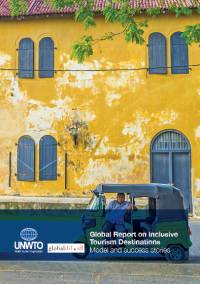 Scandic has embraced the principles of universal design throughout its hotel chain for more than ten years. This makes for an interesting case study in inclusive tourism because it goes deep into hotel operations. So it is not all about wheelchair accessible rooms – it is much more. And as always with customer service, it is the little things, such as reaching for the coffee cups at the breakfast bar.
Scandic has embraced the principles of universal design throughout its hotel chain for more than ten years. This makes for an interesting case study in inclusive tourism because it goes deep into hotel operations. So it is not all about wheelchair accessible rooms – it is much more. And as always with customer service, it is the little things, such as reaching for the coffee cups at the breakfast bar.
The case study on DOGA, the Norwegian Inclusive Design website, is to the point and shows how all hotels can benefit from small but effective changes to practices. The video below shows how they took a universal design approach. The architect said it was more about use of materials than wheelchair circulation space.
“The best evidence on that we are doing something right came from a guest. She told me that when she is staying at Scandic she is treated like a regular guest, not a disabled one”. Magnus Berglund, Scandic.
Key features on Scandic’s checklist
-
-
- Height-adjustable bed*
- Telephone on the bedside table along with the remote control
- A space of at least 80 cm around the bed
- Vibrating alarm clock and fire alarm available on request
- Hooks placed at different heights so they can be reached from a wheelchair
- Mirror at a suitable height for wheelchair users as well as standing guests
- Handrail on the inside of doors at a height that can be closed from a wheelchair
- No or low thresholds at doorways
- Single-grip mixer tap or automatic tap*
- Washbasin placed at a minimum height of 78 cm* so a wheelchair will fit under it. The hook, soap and hand towels are also easy to reach
- Toilet paper holder on the armrest of the toilet
- Hearing loop available for meeting rooms
- The doors are at least 80 cm wide, so that guests can get through with a wheelchair, crutches or a walking frame*
- The stage is accessible for wheelchair users*
-
*Only applies to some hotels.

 A new magazine,
A new magazine,  It’s one thing to create accessible, universally designed places and spaces, it is another to let people know they exist. Being physically accessible is not enough. People who need access information require detail – and they need to be able to find that detail. The tourism industry is gradually realising this, but restaurants and entertainment venues have yet to catch up.
It’s one thing to create accessible, universally designed places and spaces, it is another to let people know they exist. Being physically accessible is not enough. People who need access information require detail – and they need to be able to find that detail. The tourism industry is gradually realising this, but restaurants and entertainment venues have yet to catch up.  Inclusive tourism has two outcomes: individuals and their families can benefit from participating in tourism activity, and it can help with sustainable development and the reduction of poverty. The
Inclusive tourism has two outcomes: individuals and their families can benefit from participating in tourism activity, and it can help with sustainable development and the reduction of poverty. The Yet another excellent resource for the tourism and travel industry – an industry now leading the way in best practice. Importantly, the principles and learning from case studies can be applied everywhere. The business world should take note of the good advice in
Yet another excellent resource for the tourism and travel industry – an industry now leading the way in best practice. Importantly, the principles and learning from case studies can be applied everywhere. The business world should take note of the good advice in  Creating access maps using data collected from individuals is part of a
Creating access maps using data collected from individuals is part of a  The
The  This isn’t something from Transport for London, it’s from a blog site,
This isn’t something from Transport for London, it’s from a blog site,  Many places in the U.K. offer accessible features for guests with disability. But 63 percent don’t promote the fact according to Bill Forrester in his
Many places in the U.K. offer accessible features for guests with disability. But 63 percent don’t promote the fact according to Bill Forrester in his